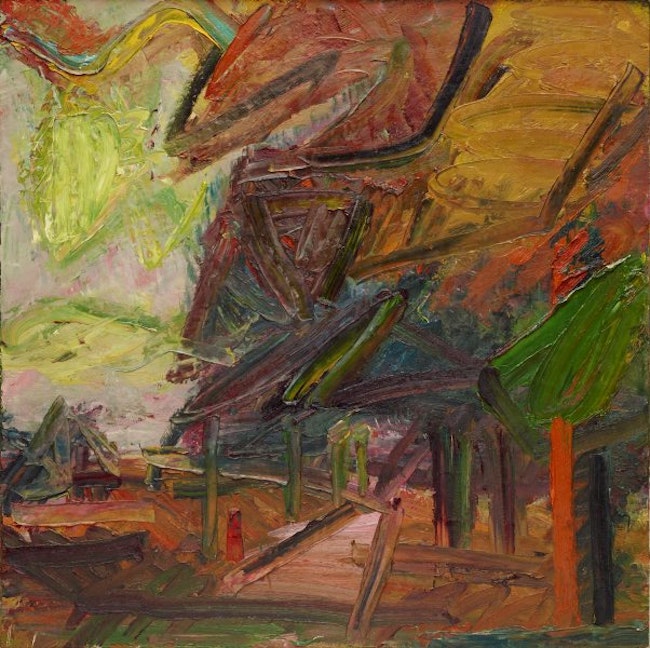The art that made me: Nicholas Harding
In The art that made me, artists discuss works in the Art Gallery of New South Wales collection that either inspire, influence or simply delight them.

Winner of the Wynne Prize 2022, Nicholas Harding with Eora, artwork © the artist
Winner of the Wynne Prize 2022, Nicholas Harding with Eora, artwork © the artist
A nine-time Wynne Prize finalist, Australian artist Nicholas Harding took out the top spot in the 2022 prize for his large-scale oil painting Eora. Harding’s verdant landscape melds personal observation with a sense of deep time. The painting is a confluence of familiar landscapes around Narrabeen Lakes on Sydney’s northern beaches and Sailors Bay walk on Sydney Harbour. The work, along with the Wynne Prize 2022 exhibition, will go on tour for the first time in the Wynne’s 125-year history.
‘“Eora” was the word used by Aboriginal people of Sydney to describe where they came from when asked by the British invaders,’ Harding has said. ‘The locations observed for this landscape are now small, dwindling pockets amongst suburban developments. The dragonflies, which are not easy to find, are symbols of change, transformation, adaptability and self-realisation.’
Harding, who has multiple works in the Art Gallery of New South Wales collection, in addition to being a finalist in the Archibald, Wynne and Sulman Prizes many times, has returned to the collection to select four paintings that have shaped him.
Rusty Peters Waterbrain 2002

Rusty Peters Waterbrain 2002, Art Gallery of New South Wales © Estate of Rusty Peters, Warmun Art Centre / Copyright Agency
In 2001, Stephen Grant of GRANTPIRRIE gallery introduced me to the Jirrawun artists Rusty Peters and Paddy Bedford in Kununarra. When we arrived at the Jirrawun archivist Francis Kofod’s house, Rusty had the first four panels of Waterbrain laid out on the concrete driveway. He sat cross-legged, focused on his painting under a large eucalypt. After greetings and introductions, we sat to observe as Rusty continued to paint. ‘Don’t worry about that bit,’ he said as he waved his laden brush to indicate an area of the ground colour, ‘I’m going to change that bit’ – something I often say to someone looking at a work in progress of mine. Leaves dropped onto the canvases and a dog walked across them as he calmly painted. Later, we had a barbecue and I drew Rusty and Paddy.
David Hockney A closer winter tunnel, February–March 2006

David Hockney A closer winter tunnel, February–March 2006, Art Gallery of New South Wales © David Hockney
David Hockney A closer winter tunnel, February–March 2006, Art Gallery of New South Wales © David Hockney
Hockney’s en plein air paintings not only evoke the fields, lanes and forested woods before him with surprising but effective colour, they also convey his delight. His observations elicit joy. Plums and hot reds bump up against intense greens. Warm blue and purple greys next to pinks, and ochres become the lush wetness of the countryside. In 2003 we had the good fortune to visit Hockney in Los Angeles. He was a most generous host, sharing his enthusiasms and curiosities for three hours in his studio before conducting a quick tour of his colourful home and garden compound. Our son Sam swam in the iconic swimming pool and the housekeeper served tea – a strong brew, as you’d expect in the household of a Yorkshireman.
Frank Auerbach Primrose Hill, autumn 1984

Frank Auerbach Primrose Hill, autumn 1984, Art Gallery of New South Wales © Frank Auerbach, courtesy of Marlborough Fine Art, London
Frank Auerbach Primrose Hill, autumn 1984, Art Gallery of New South Wales © Frank Auerbach, courtesy of Marlborough Fine Art, London
In 1985 I visited the Tate Gallery and saw Auerbach’s paintings in the flesh for the first time. They struck me like lightning. At the time I was struggling with a way forward as a painter and Auerbach’s engagement with drawn matter, to paint his observed experience, alerted me to the implicit potential for my own painting. Like the Rolling Stones covering American blues before learning to write their own songs, I began to teach myself by emulating both Auerbach and his friend and colleague Leon Kossoff. Auerbach’s erudite understanding of painting was hugely instructive.
Pierre Bonnard Self portrait c1938–40

Pierre Bonnard Self portrait c1938–40, Art Gallery of New South Wales
Pierre Bonnard Self portrait c1938–40, Art Gallery of New South Wales
Bonnard paints light. The light of the garden, a landscape or an intimate interior. He convinces us of the ‘naturalness’ of his vision with unexpected colour and compositional disposition, whether it be his wife Marthe bathing, a landscape seen through a window or a meal laid out on a table top. His self-portrait is bathed in the yellow light of an incandescent lightbulb, a solemn moment of contemplation amongst an arrangement of radiant colour that elevates the prosaic to something wondrous.
A version of this article first appeared in Look – the Gallery’s members magazine